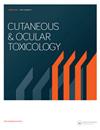Selective toxicity of Cistanche tubulosa root extract on cancerous skin mitochondria isolated from animal model of melanoma.
IF 1.6
4区 医学
Q3 OPHTHALMOLOGY
Cutaneous and Ocular Toxicology
Pub Date : 2022-09-01
Epub Date: 2022-07-21
DOI:10.1080/15569527.2022.2096628
引用次数: 0
Abstract
Abstract Introduction As a major public health issue, skin cancer is a leading reason of death and has resulted in significant financial and human losses globally. Numerous environmental and internal variables may both drive and exacerbate the pathophysiology of skin cancer. Marine herbs and animals, including marine sponges, cucumbers, and squirts, have been shown to have cytotoxic consequences on cancerous cells in prior research. Purpose melanoma mitochondria obtained from the skin of melanoma animal models are studied in this research to see whether extracts from Cistanche tubulosa, a plant endemic to the northern coasts of the Persian Gulf, have a cytotoxic impact on them. Material and method In this study, the mitochondria were isolated from melanoma cells via differential centrifugation and treated with various concentrations (1250, 2500 and 5000 µg/ml) of methanolic extract of C. tubulosa. Then MTT, ROS, MMP decline, mitochondrial swelling, cytochrome c release and flow cytometry assays were performed on them. Results The results of the MTT assay showed that the IC50 of C. tubulosa extract is 2500 μg/ml and C. tubulosa extract induced a selectively significant (P < 0.05) concentration-dependent decrease in the SDH activity in cancerous skin mitochondria. The ROS results also showed that all concentrations of C. tubulosa extracts significantly increased ROS production, MMP decline and the release of cytochrome c in cancer group mitochondria. The swelling of mitochondria isolated from the cancer group was significantly increased compared to the control group. In addition, the results of the apoptosis assay showed that the addition of root extract of C. tubulosa on melanoma cells increased apoptosis, while it had no effect on control non-tumour cells. Discussion and conclusion Based on these results, the presence of potentially bioactive compounds in C. tubulosa makes this Persian Gulf coastal herb a strong candidate for further molecular studies and clinical research in the field of melanoma cancer therapy.肉苁蓉根提取物对黑色素瘤动物模型癌变皮肤线粒体的选择性毒性研究。
导言:作为一个重大的公共卫生问题,皮肤癌是导致死亡的主要原因,并在全球造成了重大的经济和人员损失。许多环境和内部变量都可能驱动和加剧皮肤癌的病理生理。在先前的研究中,海洋草药和动物,包括海洋海绵、黄瓜和鱿鱼,已经被证明对癌细胞具有细胞毒性。目的:本研究从黑色素瘤动物模型皮肤中获得的黑色素瘤线粒体进行研究,以了解波斯湾北部海岸特有的植物肉苁梗提取物是否对其具有细胞毒性影响。材料和方法:本研究采用差速离心法从黑色素瘤细胞中分离线粒体,并用不同浓度(1250、2500和5000µg/ml)的C. tubulosa甲醇提取物处理。然后进行MTT、ROS、MMP下降、线粒体肿胀、细胞色素c释放及流式细胞术检测。结果:MTT法检测结果显示,小管藤提取物的IC50值为2500 μg/ml,大管藤提取物可选择性显著诱导(P < 0.05)凋亡。微管提取物显著增加癌组线粒体ROS生成、MMP下降和细胞色素c释放。与对照组相比,从癌症组分离的线粒体肿胀明显增加。此外,细胞凋亡实验结果显示,在黑色素瘤细胞上添加根提取物增加了细胞凋亡,而对对照非肿瘤细胞没有影响。讨论和结论:基于这些结果,管状藤中潜在生物活性化合物的存在使这种波斯湾沿岸草本植物成为黑色素瘤癌症治疗领域进一步分子研究和临床研究的有力候选者。
本文章由计算机程序翻译,如有差异,请以英文原文为准。
求助全文
约1分钟内获得全文
求助全文
来源期刊
CiteScore
3.30
自引率
6.20%
发文量
40
审稿时长
1 months
期刊介绍:
Cutaneous and Ocular Toxicology is an international, peer-reviewed journal that covers all types of harm to cutaneous and ocular systems. Areas of particular interest include pharmaceutical and medical products; consumer, personal care, and household products; and issues in environmental and occupational exposures.
In addition to original research papers, reviews and short communications are invited, as well as concise, relevant, and critical reviews of topics of contemporary significance.

 求助内容:
求助内容: 应助结果提醒方式:
应助结果提醒方式:


